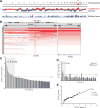TGM2: a cell surface marker in esophageal adenocarcinomas
- PMID: 24828664
- PMCID: PMC4170218
- DOI: 10.1097/JTO.0000000000000229
TGM2: a cell surface marker in esophageal adenocarcinomas
Abstract
Introduction: Esophageal adenocarcinomas (EAC) are aggressive cancers that are increasing in incidence and associated with a poor prognosis. The identification of highly expressed genes in EAC relative to metaplastic Barrett's esophagus (BE) may provide new targets for novel early cancer detection strategies using endoscopically administered, fluorescently labeled peptides.
Methods: Gene expression analysis of BE and EACs were used to identify the cell surface marker transglutaminase 2 (TGM2) as overexpressed in cancer. The expression of two major isoforms of TGM2 was determined by qRT-polymerase chain reaction in an independent cohort of 128 EACs. Protein expression was confirmed by tissue microarrays and immunoblot analysis of EAC cell lines. TGM2 DNA copy number was assessed using single nucleotide polymorphism microarrays and confirmed by qPCR. TGM2 expression in neoadjuvantly treated EACs and following small interfering RNA-mediated knockdown in cisplatin-treated EAC cells was used to determine its possible role in chemoresistance.
Results: TGM2 is overexpressed in 15 EACs relative to 26 BE samples. Overexpression of both TGM2 isoforms was confirmed in 128 EACs and associated with higher tumor stage, poor differentiation, and increased inflammatory and desmoplastic response. Tissue microarrays and immunohistochemistry confirmed elevated TGM2 protein expression in EAC. Single nucleotide polymorphism and qPCR analysis revealed increased TGM2 gene copy number as one mechanism underlying elevated TGM2 expression. TGM2 was highly expressed in resistant EAC after patient treatment with neoadjuvant chemotherapy/radiation suggesting a role for TGM2 in chemoresistance.
Conclusion: TGM2 may be a useful cell surface biomarker for early detection of EAC.
Conflict of interest statement
Disclosure: The authors declare no conflict of interest.
Figures





References
-
- Dubecz A, Solymosi N, Stadlhuber RJ, et al. Does the Incidence of Adenocarcinoma of the Esophagus and Gastric Cardia Continue to Rise in the Twenty-First Century?-a SEER Database Analysis. J Gastrointest Surg. 2013;18:124–129. - PubMed
-
- Barrett NR. The lower esophagus lined by columnar epithelium. Surgery. 1957;41:881–894. - PubMed
-
- Cameron AJ, Carpenter HA. Barrett’s esophagus, high-grade dysplasia, and early adenocarcinoma: a pathological study. Am J Gastroenterol. 1997;92:586–591. - PubMed
-
- Kariv R, Plesec TP, Goldblum JR, et al. The Seattle protocol does not more reliably predict the detection of cancer at the time of esophagectomy than a less intensive surveillance protocol. Clin Gastroenterol Hepatol. 2009;7:653–8. quiz 606. - PubMed
Publication types
MeSH terms
Substances
Grants and funding
LinkOut - more resources
Full Text Sources
Other Literature Sources
Medical
Molecular Biology Databases
Miscellaneous

